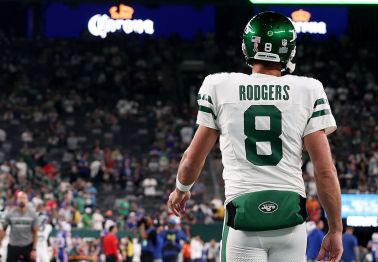New York Jets quarterback Aaron Rodgers is out for the season with a torn achilles, and the injury is as bad as it sounds.
An MRI performed early Tuesday morning confirmed what many suspected after watching video like this:
New slow-mo video angle of Aaron Rodgers injury. Ankle fracture +/- dislocation. Only good news here would be isolated dislocation. Robert Griffin was back playing in 7 wks. Much younger though.
pic.twitter.com/qGcf6y9ZIe— Dr. Mark Adickes (@jocktodoc) September 12, 2023
Aaron Rodgers' Jets career may have lasted just four plays, ended by an Achilles rupture. The energy that can be seen in the video recalls that of basketball's Kevin Durant famously rupturing his Achilles when he was with the Warriors. The thick, tight fibers of the tendon let go, with most of the energy going toward the calf muscle, which uses the tendon to act on the heel.
An Achilles rupture (a complete tearing of the fibers, or a Grade III strain) was likely known seconds after. Not only would Rodgers have felt it give, but athletic trainers and doctors use a manual test called the "squeeze test." It's simple and accurate, squeezing the calf to see if the heel reacts. When it doesn't, the Achilles is no longer attached and able. MRIs, X-rays and ultrasounds only confirm what was likely known on the field.
The next step (no pun intended) for Rodgers is surgery to repair and reattach the tendon. The surgery is simple and very successful. That's especially true with changes in technique that came in about a decade ago, often timed to Kobe Bryant's Achilles surgery; Dr. Neal ElAttrache used a smaller, tighter pattern of sutures that healed in a way that minimized side effects and maximized strength. Players including Bryant, Terrell Suggs and Cam Akers came back well, on about a six-month time frame.
There's a lot of speculation about whether the MetLife turf contributed to this. The spike-turf connection has long been debated, but there's simply no way to know. Achilles injuries can happen on grass as well — as it did Sunday with J.K. Dobbins, who was playing at M&T Bank Stadium in Baltimore, where the field is a special bluegrass hybrid. Studies have shown that more foot and ankle injuries happen on turf, but those studies also show that more foot and ankle injuries occur at certain stadiums. MetLife's FieldTurf had just been replaced in the offseason, and there's no clear sign that Rodgers was near a seam or caught his cleat.
Rodgers is likely to visit surgeons early this week. Most Achilles injuries go to Dr. Robert Anderson, now back in Charlotte but previously the Green Bay Packers' team doctor, so Rodgers will have some familiarity. ElAttrache, the Rams' and Dodgers' surgeon, is also a regular choice of players. Anderson recently did toe surgery on Red Sox outfielder Jarren Duran, who called him "Foot Jesus" in talks with the media.
It'd be easy to make jokes about Rodgers' iconoclastic takes on modern medicine, but in this, he's likely to stick with the tried-and-true and scientifically proven. He'll have the best of care and likely will rehab at least in part with the Jets medical staff. At age 41, there's no reason to believe that his Achilles won't heal well. But will Rodgers want to play another season of NFL football, and will the Jets want to pay him to do so? That remains to be seen and likely depends on whether Zach Wilson plays better than he did last year — which is the reason the Jets spent big to get Rodgers in the first place.
Expect Rodgers to have surgery as soon as this week, but there's no chance he will return for the 2023 season. The ball is now Wilson's, and Rodgers will start his rehab journey — wherever that may lead.

